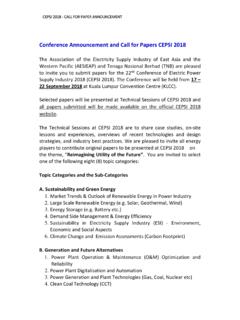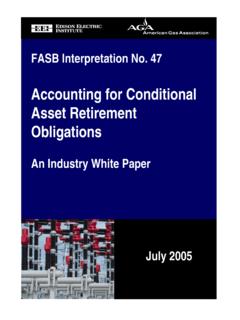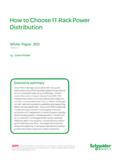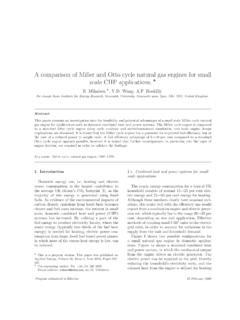Transcription of US Power Generation Fuel Mix - FutureMetrics
1 FutureMetrics LLC 8 Airport Road Bethel, ME 04217, USA FutureMetrics Globally Respected Consultants in the Wood Pellet Sector Wood Pellet Fuel: A Solution to Reliable Baseload Low Carbon electric Power Generation By Dr. William Strauss May 2014 [While this white paper focuses on using wood pellets for Power Generation , we believe that wood pellets for heating in areas where the climate is cold is an important and vital part of the solution to reducing our dependence on fossil fuels and lowering our carbon emissions. FutureMetrics has a number of white papers on that topic.] The transition from fossil fuels to low carbon emitting renewable energy for Power production is necessary if we are going to mitigate the carbon effects on climate change. But there are serious constraints to the typically envisioned pathway of using wind and solar Power . For every megawatt of wind and solar generating capacity there has to be a megawatt of thermally generated or hydro capacity otherwise if the wind is not blowing and the sun is not shining, some of the lights will go out.
2 Thermally generated baseload Power can come either from combusting a fuel or from nuclear Power . In some select locations, hydro, geothermal energy, and ocean current energy can be used to generate Power . For generations the combustion fuel of choice has been coal and, if the future unfolds as the US Energy Information Administration (EIA) predicts (shown in the chart below), coal and natural gas s contribution to the US Power portfolio will remain more or less constant at about 70% of the total. The proportion of renewable energy used in the US is forecast to grow only slightly. KWh's per YearUS Power Generation Fuel MixOil and other liquidsCoalNatural gasNuclearRenewablesource:EIA, 2014, analysis by FutureMetricsForecast ===> FutureMetrics LLC 8 Airport Road Bethel, ME 04217, USA FutureMetrics Globally Respected Consultants in the Wood Pellet Sector The EIA forecasts are wrong We believe that as the impacts of carbon emissions over the next decade create climate change events that are increasingly threatening to business as usual, the US will alter its policy into one that follows the lead of much of the rest of the developed world.
3 That will lead to policy that will transform our energy infrastructure. If coal and natural gas Generation is to be reduced, that will mean that baseload Power will have to come from fully dispatchable, reliable, and low cost (but also low carbon) generators. As will be described below, that low cost and reliable technology to satisfy those needs exists now. The following two charts compare the EIA forecast for US renewables to the European Union s (EU) actual use of renewables. Comparing the US forecast to the EU s past decade (below), it is obvious that biomass has a starring role in the EU and a less important part in the US. The EU s use of biomass today is greater than the EIA projection for the US in 2040. Also, in the EU, many Power stations use the rejected heat from the turbine steam cycle for district heating (combined heat and Power or CHP) which provides a significantly improved efficiency in converting the energy in the fuel into useful energy.
4 However it is important to note that of the renewables in the EIA forecast, only biomass has any significant growth. 050,000100,000150,000200,000250,000300,0 0020112012201320142015201620172018201920 2020212022202320242025202620272028202920 3020312032203320342035203620372038203920 40 Thousands of Tons of Oil EquivalentShare of Renewable Energy in the USBiomassHydroelectricWindGeothermalMuni cipal Solid WasteSolar ThermalSolar Photovoltaicsource:EIA, 2014, analysis by FutureMetricsFutureMetrics LLC 8 Airport Road Bethel, ME 04217, USA FutureMetrics Globally Respected Consultants in the Wood Pellet Sector The big difference between the US and EU is the recognition that biomass Power is a valued and essential part of the renewable energy portfolio because it plays a key role in decarbonizing the Power and heat sectors and it is reliable and produces as needed. US policymakers and many renewable energy advocates have focused on wind and solar (and to a lesser degree on tidal and wave technologies) for renewable electricity Generation .
5 There is certainly an attraction to free fuel that does not require combustion or have the issues associated with nuclear Power . But even with the expectation that the cost of wind and solar generated Power reach some parity with conventional coal and natural gas Power plants, they have a big problem with reliability and dispatchablity. Wind and solar cannot respond to fluctuating demand and they cannot be expected to generate as needed. For wind, there are periods when there isn t any or the velocity is low. A very good wind resource may have a capacity factor of 40%. That means that if the turbine is rated for 4 MW, it will on average produce 40% of that ( MW). Some periods it will produce 4 MW and some periods zero MW. Most land based wind farms have capacity factors of less than 30%. For solar PV there is the inevitability of nighttime; which in the northern latitudes, when it is winter, can last for 15 or more hours.
6 For concentrating solar thermal generators that store some energy for nighttime Generation , the energy flux necessary to store energy for generating through the night limits those projects to lower latitudes and desert climates. 020,00040,00060,00080,000100,000120,0001 40,000160,000180,000200,0002001200220032 00420052006200720082009201020112012 Thousands of Tons Oil EquivalentShare of Renewable Energy in the EU (28 countries)BiomassHydro powerWind powerSolar thermalSolar PVTidal, wave, oceanBiogasMSW (garbage)BiogasolineBiodieselGeothermals ource:Eurostat, 2014, Analysis by FutureMetricsFutureMetrics LLC 8 Airport Road Bethel, ME 04217, USA FutureMetrics Globally Respected Consultants in the Wood Pellet Sector The solution is already here. Biomass Power is reliable, is dispatchable, is low cost, and is low carbon. The technology for efficient production of Power from biomass is well proven and in operation in many locations around the world.
7 But even more compelling is the ability of existing coal fueled Power plants to convert at relatively low cost to use wood pellets instead of coal. There is no need to build a dedicated Power plant for using biomass when there is a vast fleet of coal plants whose pulverized coal burning systems can be converted to use pulverized wood pellets1. For example, the Drax Power station in the UK, the UK s largest Power station at nearly 4000 MW s, has one of its six 650 MW units running on 100% wood pellets. The unit s efficiency ( ) matches that of its neighboring units running on coal. The net carbon emissions reduction are significant: about million tonnes per year not emitted. The Drax station took an existing coal fired boiler and converted it from using pulverized coal to using pulverized wood pellets. The retrofit of this large Power boiler, including all the fuel storage and handling, has been successful. The wood pellet fueled line has been providing baseload Power reliably and efficiently since April 2013.
8 Another example is Ontario Power Generation s (OPG) Atikokan station. OPG has converted a 200 MW coal station into a 200 MW wood pellet station. That facility is scheduled to begin generating on pellets later in 2014. Every pellet that is fed into that Drax and OPG burners has a chain-of-custody certifying that they were sourced from a sustainable working forest. And sustainability is an absolutely necessary condition that must be met for biomass Power to be truly renewable and part of a decarbonization strategy. The fuel must be procured from sustainable sources. The wood that becomes pellets that fuels converted coal Power stations must be harvested such that the stock of wood in the working forests is not decreased. Growing forest crops sustainably for lumber and paper has been going on for generations. Most forest landowners manage their working forestland to produce wood from periodic harvests and expect to be harvesting for generations to come.
9 As long as the markets for wood remain strong, the forests that have been working forests for generations will continue to be working forests providing a never ending source of feedstock for lumber, paper, heat, and Power . To understand the basic foundation for sustainable (and therefore renewing) forests, one has to look at how forests are managed for growing trees. There are many plots and subplots of trees in the US working forests at many stages of growth. Imagine a plot of 10,000 acres that has a growth rate for pellet quality feedstock of 2 tons per acre per year. That means that every year there are 20,000 tons of new growth. If no more than 20,000 tons of the pellet quality fiber in a subplot of that 10,000 acres are harvested each year, the stock of the raw material for making wood pellets remains constant. The next year there will be another 20,000 tons; and so on forever. 1 Advances in making black pellets (torrefied and steam exploded) suggest that in the near future those coal plants will be able to use a product made from wood that is similar to coal.
10 FutureMetrics LLC 8 Airport Road Bethel, ME 04217, USA FutureMetrics Globally Respected Consultants in the Wood Pellet Sector Not only does the stock of wood remain constant but for every ton that becomes fuel, the carbon released in combustion is recaptured by the new growth. The carbon stock of our sustainable 10,000 acres also remains constant even as the harvested wood is converted into refined wood pellet fuel for as long into the future as needed. Therefore, wood pellets from sustainable working forests are carbon neutral in combustion. They do, however, have a carbon footprint. That is from the electricity used in the manufacturing process (unless the Power is also from biomass) and from the transportation component of the supply chain (diesel and bunker fuel for trucking, rail, and shipping). But all fuels, including coal, natural gas, and petroleum based fuels, acquire a similar carbon footprint from their own supply chains.








